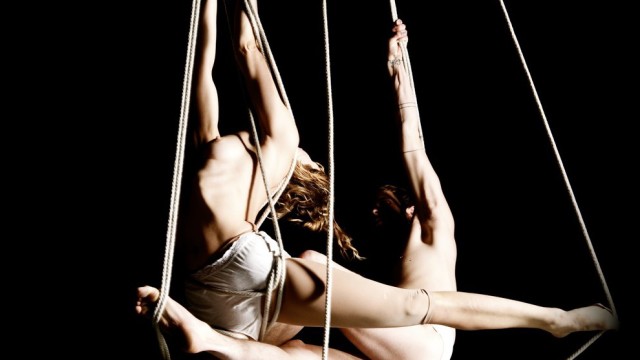Circomedia, Bristol; 29th April, 2016

Smoke & Mirrors, the show that jointly won last year’s Jackson’s Lane Total Theatre award for circus at Edinburgh Festival Fringe (with B-Orders) is back in the UK for a short tour after the company of two, Cohdi Harrell and Laura Stokes, recently relocated from New Mexico to Europe.
In a heart tugging display of grace and awkwardness, the pair explore themes of personal isolation in a corporately driven world, through a choreographic blend of contortion, dance and aerial technique. The focus is on expressive movement rather than pristinely executed tricks, which makes the circus artists intensely engaging as they perform their highly skilled routines.
Harrell and Stokes have worked together for ten years as The Ricochet Project, as well as producing their own solo work, and Smoke & Mirrors is five years old. The social issues it addresses still feel relevant and fresh today, especially in the field of circus work. For all its struggle with depersonalisation, however, Smoke & Mirrors is not a bleak piece, but essentially human on a level that all our hearts can connect to.

A soundtrack of found songs, silence, and repurposed speech layers context onto the physical performance, and the show begins with a slightly distracted voice reciting figures: 3.2 million. 6 million. 1.3. Dollars. In the blackout as Harrell and Stokes enter the stage, the first shapes our eyes make out are his white shirt collar and her briefcase.
On the trapeze they trample over each other, perfectly oblivious, following their own predetermined patterns within the frame. When a hang becomes a contortion, we sense that there is something grotesquely satirical to this play of corporate imagery.

When the day ends, the pair find their own corners of the stage. Teeth are brushed, layers of clothing removed. A new scene is heralded by a fade out of lights and music, and we witness Harrell performing an inquisition on himself under a pendulous lamp. He percussively manipulates his body manually as well as from within, his tie swinging about his neck like a fifth limb. The staccato of his dance is powerfully broken with a slow cartwheel across a wooden chair, or a compressed slide through its back.
From darknesses emerges a new sound, a mournful chanting song, and Stokes is supporting herself on a double aerial rope. The ropes are twisted together into a deliberately unsightly knot at the top, a visible symbol of the unsightly knots of bodies and minds that form the crooked backbone of the show.

If Harrell’s solo was characterised by a staccato movement, Stokes’ contorting aerial routine is a returning vibrato – a shaking leg, a twitching neck, a quivering wrist. In a choreography of bold clear moves, it is these tiny glimpses of fragility that show us the psychology of underlying stress in a world of hyper-control.
As she slowly crawls, head first, down the ropes, a white strobe begins. Harrell enters her space through a doorway formed from the ropes, and they co-exist. A child’s voice lists things about themself, overlaid by a crackling radio broadcast and neo-classical piano. One crawls like a hermit-crab, trapped in a shell of chairs. One hangs by his feet from the trapeze.
An exquisite solo from Harrell becomes a relationship of tortured freedom, as he and the trapeze partner each other. The suspending ropes are wrapped, flicked and clenched as he orders his body to move with a snap of his fingers. This is a rare combination of technical and artistic excellence, as he hangs from his heels neurotically tapping his face, flings himself in elbow-rolls around the bar, or stands, tremulous in a hands-free balance.

This is about one person, then another, there’s no room for personal relationships in the world of Smoke & Mirrors. Stokes is now balancing on her bare breasts, legs backwards over her head, shivering. She tumbles over herself, changing axis and orientation. The pair dance simultaneously, each becoming their own captor forming bonds and manacles for themselves physically and, by extension, metaphorically in this simulation of a workaday business world. Naked but for their underpants, they attempt to support each other but, floppily incapable, still end up alone.
As the suspended lamp swings again between them and us it highlights our interchangeable lives.
A third rope is released to form a sling for Harrell and the pair finally begin to make a connection in a doubles routine on the vertical ropes, accompanied by Charlie Chaplin’s humanitarian speech from ‘The Great Dictator‘. The two bodies share the best of what we can be – intimacy, support, care, kindness, love of life. They descend to the floor and, for what feels like the first time, make eye contact. It’s beautiful, and when they look away again so soon I want to cry.
The pair return to the symbols of an impersonal life, and I want to call out ‘Don’t do it! Live!’. But the show ends, and their existence, we suppose, continues as it did before.
The Ricochet Project played for two nights in Bristol and, the following Monday, were invited to discuss their work in a public session hosted by Circus City. The conversation moved through issues of gender representation in circus, creatives processes, and technicalities. A full report can be found here.





[…] mass acrobatics of Cie XY from France, the political circus-dance-theatre of the American Ricochet Project, and the 6th generation Circus Ronaldo from Belgium), local talent is also given a strong platform. […]